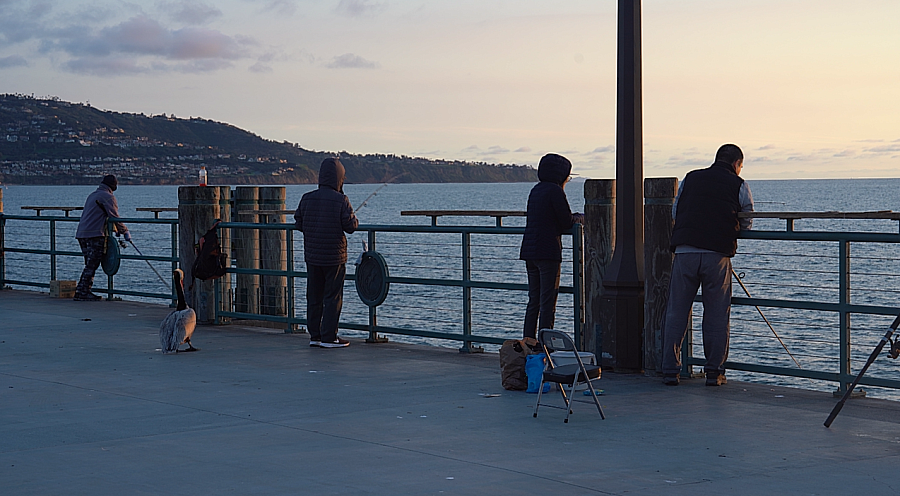Fishing in the Red Zone: The toxic legacy threatening LA’s subsistence fishermen

Photo by Jackson Hudgins
Between 1947 and 1971, the Montrose Chemical Corporation piped more than 1,700 metric tons of the synthetic insecticide DDT directly into the Pacific Ocean, just off the coast of Palos Verdes, California. Wastewater from the chemical facility in Torrance — the nation’s largest — flowed through Los Angeles County’s sewer system to marine outfall pipes offshore, where billions of gallons of toxic effluent eventually settled over an area of about 17 square miles.
Today, that slice of the continental shelf is the largest known area of DDT contamination in the world, a Superfund site where highly contaminated sediment rests, in some areas, 2 feet thick. More than half a century later, many bottom-feeding fish in the region remain unsafe for human consumption.
And yet thousands of fishermen in the Los Angeles Basin — the vast majority of them immigrants and people of color — consume what they catch to help feed themselves or their families.
Some are unaware of the danger lurking at the ends of their lines. Others are skeptical. Many simply heed the posted warning signs and avoid fish like the white croaker or topsmelt. But all of them cast into what’s known as the “red zone,” a 50-mile stretch of popular and densely populated waterfront that runs from the Santa Monica Pier to Seal Beach, where impacts from this pollution are most acute.
And as research uncovers new evidence of unregulated chemical dumping in the postwar era, including the previously unidentified systematic disposal of DDT and radioactive waste farther offshore, the work of protecting LA’s subsistence fishermen has taken on a new urgency.
These anglers are a unique demographic, distinct from commercial or sport fishermen. They often cast their lines from public fishing piers, locations that require no permit. About 60% identify as Latino, and 84% speak English as a second language. Four out of five report they are fishing to supplement their diet. And most hail from neighborhoods that already bear some of the highest pollution burdens in California, like Hawthorne, Compton, or South El Monte.
In other words, in a city where approximately 1 million households are food insecure, pier fishing isn’t just recreational — it’s often a tool for survival.
The goal of this project for the 2024 California Health Equity Fellowship is to document the lived experiences of Southern California’s subsistence fishermen, while tracing the toxic legacy of chemical manufacturing that threatens their health today. How many are consistently consuming fish on the warning lists? How many are aware of the dangers? To what extent do external economic factors — high housing costs, inflation, and the rollback of pandemic era food assistance programs, for instance — influence someone’s decision making along the waterfront?
It will also spotlight the Angelenos who have been working for decades to protect anglers from potential harm.
One of those people is Frankie Orrala. As the director of Heal the Bay’s Angler Outreach Program, an initiative overseen by the U.S. Environmental Protection Agency, he and his staff educate community members on the dangers of contaminated fish. His teams distribute information at piers in a variety of languages, like Spanish, Vietnamese, Tagalog, Russian and Chinese. They attend community events and work with local bait shops. Since 2003, the AOP has interfaced with nearly 200,000 fishermen. But it is a never-ending task: they are called “forever chemicals” for a reason.
Health impacts linked to exposure to DDT include cancer, liver disease, and disruption of the immune and endocrine systems. Unregulated chemical dumping from the 20th century will impact coastal fisheries in Los Angeles deep into the 21st.
In practice, this story will involve significant time on the city’s piers, meeting and talking with fishermen. It will also require a straightforward explication of the science behind the extraordinary persistence of DDT in our environment and its potential consequences. It will be important to accurately characterize both the health risks and the prevalence of consumption of contaminated fish, while avoiding sensationalism or fearmongering.
This reporting project will include both a written and video piece. The goal is to hear from fishermen in their own words while synthesizing and communicating the science. If all goes well, we can help readers better understand the historical, social, environmental and economic factors at play each time someone drops a line in the water off one of LA’s many fishing piers.